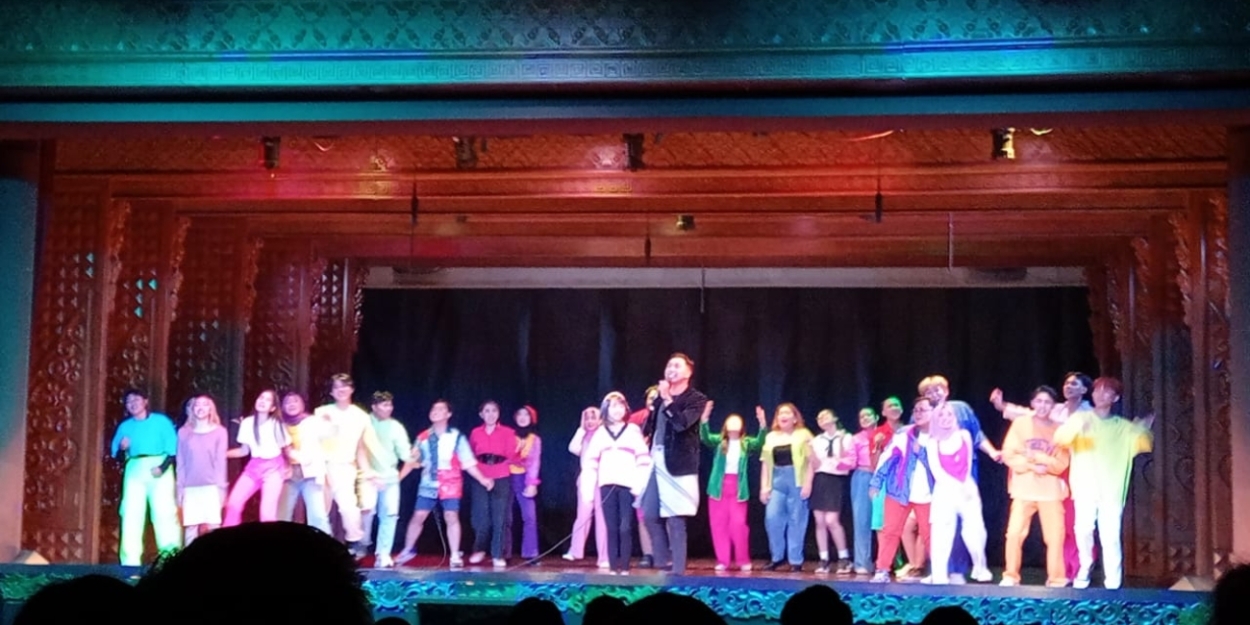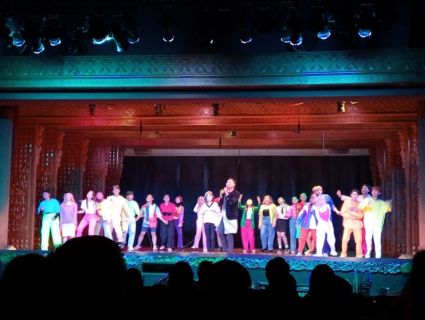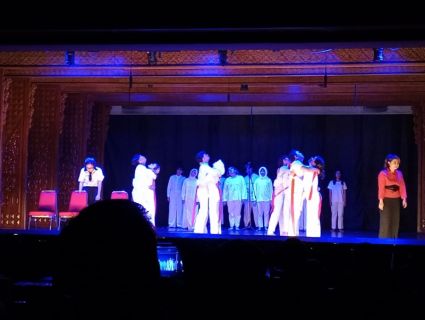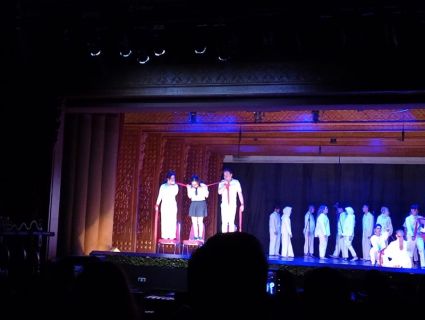Review: CERITA BEDA HAK SAMA 2 Sheds Light on the HIV/AIDS Stigma
The show ran on 10 December 2023 for two shows.

Review and photos by Geovanni Audrey Suhartono, editing by Rakaputra Paputungan.
CERITA BEDA HAK SAMA 2 is a rerun of the original show that was performed back in 2019 and 2020 to commemorate World AIDS Day. The show ran twice at 3 pm and 7 pm on 10 December 2023 at Gedung Wayang Orang Bharata. This review is written based on the first show. The show’s proceeds will be donated to Yayasan Syair Sahabat, a foundation working to support children with HIV/AIDS
The story opens with a rainy scene at night. A young woman, Caca (Abel), knocks on the front door of her best friend, Bila (Venesia Simanjuntak). She’s not there to simply refuge from the rain. Rather, she’s leaving a baby in Bila’s care, alongside a letter expressing the circumstances that force her to leave her child.
Some years later, young Esok (Pija) turns out to be HIV positive. Bila, as her mother, reminds her to take her vitamins for her condition, which Esok reluctantly does. Fast forward, an elder Esok (Nabila) is getting ready to go to school, almost forgetting to bring her medicines until her mother reminds her.
At her school, there’s a fair showcasing the different school clubs. The students perform a well known Indonesian number, Ekspresi by Titi DJ. Throughout this performance, Esok takes photos of her surroundings.

The flirtatious president of the photography club, Beni (Dedi) notices her. He then inducts her into his club without asking for Esok’s agreement. She’s then introduced to the other club members, who welcome her warmly. As she chats with the vice president of the Photography club, Vigo (Meliza), her bottle of meds falls out of her bag.
The next scene sees a best friend of both Bila and Caca, Alisha (Medina) visiting Bila at her boutique. They reminisce about their youth, performing Ratu Sejagad, with the mannequins coming to life and an eye-catching choreography. As the number ends, Alisha applauds Bila for being strong and raising Esok, who is not only not her own biological daughter but also HIV positive. Bila retorts that Esok is just like any other child, and her choice to become Esok’s parent is not a prestigious act but a human one. Bila believes that Caca would also do so if their positions were reversed.
Shortly after, Esok arrives at the boutique with a letter from the school’s guidance counselor, addressed to Bila. Bila skims through it and sends Esok to the car to wait with Alisha. She then reads the letter, which seems to notify that she has been summoned for a meeting at school.
During the meeting, the Guidance Counselor (Kania) reminds her of the circumstances that sets Esok apart from her peers. Bila argues that Esok shouldn’t be treated any differently, and that she has the same rights as every other child. She reinforces the fact that Esok is in good health and therefore does not require any special treatment.
Meanwhile, Esok arrives at the Photography Club, which incites the anger of Vigo. Vigo and the other members taunt and humiliate Esok for her condition, slandering her for not only hiding her status as an HIV positive but also for "trying to spread the virus". Beni comes to Esok’s defense, only to cause his peers to turn against him as well, saying that he must’ve also contracted the virus and many other derogatory jabs. Overcome with anger, Esok lunges at Vigo.

In the aftermath, the Principal (Riki) calls Bila to school, and expels Esok. He and Bila argue, and he brings to light that Esok’s condition does not only incite the bullying incident. Even the students’ parents and guardians protest against Esok’s presence at the school. He attempts to hand a list of school recommendations to Bila, offering to refer Esok to other schools accepting of her condition, but Bila refuses.
Bila wanders alone, in the midst of the ensemble all dressed in white, as she sings, almost in tears. She hugs the younger Esok, protectively as she retreats.
The scene changes into the number Berhenti Berharap, by Sheila on 7, with both Esok and Bila singing their hearts out. This scene moved me the most, with the ensemble holding their red cloth strips and tangling them onto Esok, depicting the burden and struggles she faces. At the end of the number those strips become the very thing that Esok hangs herself from, causing Bila to let out an anguished cry.
Soon the scene dissolves, and Esok, Bila and the ensemble burst into energetic and bright renditions of Merakit by Yura Yunita and Manusia Kuat by Tulus. After all these exciting numbers, it seems that everything has been merely an imagined scenario. Bila states that the ending is left to the audience’s jurisdiction, as Esok is seen to be lifeless. Here she imparts the core of the story’s message. The virus in Esok’s body may be dormant, but the stigma can still destroy Esok’s future. "Stigma masyarakat, membunuh lebih cepat" The people’s stigma, kills faster.

Before anything, it is truly a feat in itself to bring such a meaningful message and convey it through musical theatre, in such an accessible and digestible way, without watering down or diminishing the weight of the message. I think this is an amazing way to spark awareness in people without sounding patronizing at all.
I’d like to really commend the production’s choreography. The way they made use of the stage and movement was truly enchanting. There were various styles, and the cast and ensemble truly brought their A game when it came to dancing. The formations were neat, and I could see everyone putting their heart into each move. The somber and emotional scenes were brought to life, visually, and made the experience that much more visceral.
Unfortunately, not the same can be said about the vocals. Part of the issue stems from the sound, as the voices seemed to fade in and out. Some of the ensemble’s voices overpowered the main cast, and some dialogues were extremely hard to capture, making the story quite hard to follow at times. The choreography was also heavy, which made the vocals rather shaky and lacking support. However, my notable favorite was Esok. Esok’s voice had so much character and feeling, and she was very stable throughout. The acting however truly saved the day.
The sad parts felt very harrowing, especially Bila’s performances during what I perceive as the most emotional scene. The pain in her voice and body language made my heart ache. I did love the sass from most of the characters, especially the best friend Alisha, who also brought a lot of humor to the show. The characters had me rooting for them, and I could sympathize with each of them.
Another notable point was the transitions. They seemed to take up an alarming amount of time, to a point where people in the audience were murmuring. The waiting was nearing a point of uncomfortableness, but I could see why they needed time, with the many costume changes and other logistical issues.

The props were simple but effective. The costuming is another charming point of the show. I loved how vibrant it could be during the lighter scenes, and how the costumes played such a role in the delivery of the musical as a whole.
The music was at times overpowering, making it hard to catch what the actors were saying. Especially during the curtain call, as each cast and crew member were given credit. I noticed some mics being wired handhelds, which seemed to also hinder movement and can be quite a safety hazard.
Another thing I really loved was that, I found out after the show, was that the closing song was a sort of theme song for the Cerita Beda Hak Sama community, and that they always sang that song after each production. It had a positive message and was really enjoyable.
All in all, I still have endless praise for how the community is doing this for such an important cause, and bringing forth such an important message. They did incredibly well despite all the obstacles, and really are pushing for change with their art. Big props to the production team and the cast. I am looking forward to more of Cerita Beda Hak Sama’s productions.
Reader Reviews

Videos

